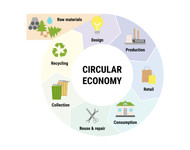Circularity’s Role in Climate: How Foodservice Packaging Can Help to Close the Loop
Posted by Eco-Products on Apr 30th 2025

Understanding Circularity
Circularity is gaining traction for being an effective climate strategy that aims to minimize resource extraction and waste.
The circular economy is an economic system designed to keep materials in use as long as possible, with the goal of eliminating waste. It differs from the traditional linear economy, which follows a “take, make, dispose” model. Circular systems focus on material design that allows products to be repaired, reused, and regenerated at the end of their life. This approach reduces resource extraction by minimizing the need for virgin materials, lowers energy use through efficient production and transportation, and strives to minimize waste by extending product lifecycles. Many businesses across sectors have begun to see the benefit of adopting circular economy practices, including the foodservice packaging industry.
Circularity and Foodservice Packaging
Given its prevalence in our daily lives, foodservice packaging offers a significant opportunity to reduce waste and mitigate climate impacts through the adoption of circular economy principles. This can be achieved through several key strategies, including choosing certified compostable packaging, using reusable containers when in a closed loop system, and investing in recycling infrastructure to ensure packaging is designed for recyclability, keeping materials in continuous use. Each of these packaging categories falls under the principles of circularity. When certified compostable packaging is processed at a compost facility, it reduces landfill waste and methane emissions, while also allowing the renewable resources the product is made from to break down into a valuable soil amendment. Finished compost, when applied to land, has many climate benefits. In closed loop systems, using reusable containers encourages the reuse of containers, contributing to a longer product lifecycle. Standardizing recyclable materials for acceptance at a materials recovery facility (MRF) allows for increased recovery rates, higher end market demand, and the ability for a product to be recycled repeatedly.
Circularity in foodservice packaging isn’t just about reducing waste – it's about addressing climate change at its root. By rethinking packaging systems and prioritizing circular design, industry can work to cut emissions, reduce waste, conserve resources, and contribute to a more sustainable and resilient future.
The Benefits of Circularity
Beyond acting as a key climate mitigation strategy, circularity can offer numerous benefits. The circular economy creates economic opportunities through innovation of new business models and enhances resource security by reducing reliance on finite resources.
Achieving the full climate benefits of circularity in foodservice packaging requires a collaborative and holistic approach, encompassing mindful material choices, innovative system design, and robust infrastructure development. By prioritizing these circular strategies, the foodservice packaging industry can significantly contribute to a future where foodservice packaging contributes to a more sustainable, circular economy.

